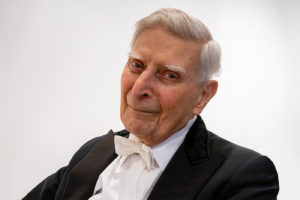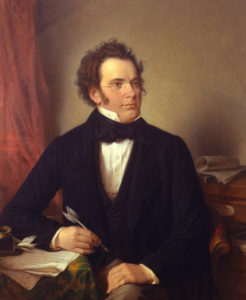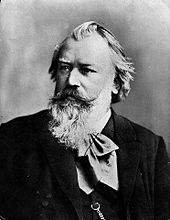January 30 – Davies Symphony Hall – Herbert Blomstedt conducted the San Francisco Symphony in the Symphony No. 5 in B-flat major, D. 485, by Franz Schubert (1816) and Symphony No. 1 in C minor, Opus 68, by Johannes Brahms (1855-76). When I hear the great music played by the SFS, conducted by Herbert Blomstedt, I feel that I know what the music was composed to be from every sound. Maestro Blomstedt’s authority comes from his deep knowledge of every step in the music. He leads the musicians into the world of the music. There is no ego that others might flash for their interpretations of the composers’ musical ideas or other ideas put upon the music. His strength and honesty makes the audience realize she is experiencing the truth.
 Herbert Blomstedt, Conductor, photo by Jonathan Clark
Herbert Blomstedt, Conductor, photo by Jonathan Clark
Schubert’s Symphony No. 5 opens a lovely spring time. Listening to this Symphony gives the audience and orchestra the full experience: walking among flowering trees, hearing water move, enjoying the sunshine which is not going to burn. It is a model of the graceful moments in nature and in our human nature. There is no down side to the physical presence we see on our walk. The music is light but not slight. Of the four movements, only one is not Allegro. Serious music does not require tragedy. To experience this music one can recall a garden or imagine the Garden. It is a gift.
 Franz Schubert, Composer (1797 – 1828)
Franz Schubert, Composer (1797 – 1828)
The San Francisco Symphony performed majestically in both symphonies. Maestro Blomstedt found ways to pour the right energy in for these disparate emotions and music. Often it seems that comments on Brahms’ Symphony No. 1 are mostly about how long it took to materialize. An expert commentator calls it “burly.” I do not think that is 100% fitting. What is burly? Yesterday I saw pictures of a grizzly bear with her cub. Later, the grizzly bear was run down by a vehicle. The cub was orphaned. These bears are bigger than humans and will protect their young. “Burly” is not adequate for the bears either. The first movement comes forward without any dodges; not wasting time working up to being Big. It is powerful, beautiful, and alarming. This is an entrance of the earth; massive storms, floods, giant trees, mountains. Brahms may have needed 14 years to become the Brahms who pulled the Symphony No. 1 out of all he learned while composing other great works. He was inspired by his own work, and it is something only Brahms could do. It is all new. it starts and will not let go until all of it can exist. When I hear the sudden switch to the glorious theme, I cry. I do not know why that happens. Having the opportunity to see Herbert Blomstedt back stage, I asked him, “what makes me cry exactly at that moment?” He thought for a second and told me: “It is a revelation.” That is it. A vision. A perfection.
 Johannes Brahms, Composer (1833 – 1897)
Johannes Brahms, Composer (1833 – 1897)
Maestro Blomstedt was Music Director of the San Francisco Symphony, chief conductor of the NDR Symphony Orchestra, and music director of the Leipzig Gewandhaus Orchestra. He has conducted at Copenhagen, Stockholm, Dresden, and the Bamberg Symphony and the NHK Symphony Orchestra. All of these honored him as Conductor Laureate. He has been given honorary doctorates, was elected to membership in the Royal Swedish Music Academy and was awarded the German Great Cross of Merit with Star. He continues to lead orchestras around the world.
His San Francisco audience cheered him and applauded without pause.